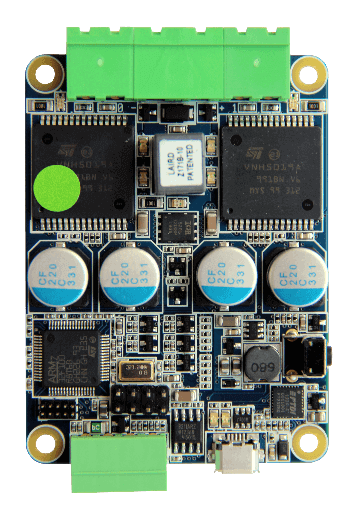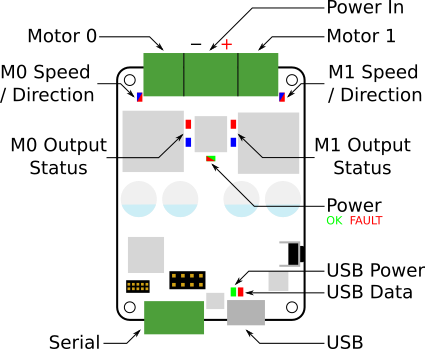Motor Board
 The Motor Board can be used to control two 12V DC motors. Your kit contains two of these boards to allow you to control up to four motors. These can be used for moving your robot, although don’t feel you are limited to using them for this purpose.
The Motor Board can be used to control two 12V DC motors. Your kit contains two of these boards to allow you to control up to four motors. These can be used for moving your robot, although don’t feel you are limited to using them for this purpose.
The speed and direction of the two outputs are controlled independently through the USB connection. The board also needs power delivered from a 12V port on the Power Board in order to drive the motors.
The motor board uses pulse-width modulation (PWM) to control the amount of power that is sent to the motors.
You can control the motors using the Motor Board API.
Board Diagram

Indicators
| LED | Meaning | Initial power-up state |
|---|---|---|
| Power | Green when powered correctly Red when polarity is wrong for Power In |
Green |
| M{0,1} Speed/Direction | Brightness indicates speed, colour indicates direction | Off |
| M{0,1} Output Status | Blue indicates more than 50% load (5A) Red indicates a motor driver fault |
Off |
| USB Power | The USB interface is powered | On |
| USB Data | Data is being transferred to/from the board | Off |
Case Dimensions
The case measures 70×84×20mm. Don’t forget that the cables will stick out.
Specification
| Parameter | Value |
|---|---|
| Nominal input voltage | 11.1V ± 15% |
| Absolute maximum input voltage | 16V |
| Minimum input voltage | 9V |
| Output voltage | 11.1V ± 15% |
| Continuous output current per channel | 10A |
| Peak output current 1 | 20A |
| Serial connection voltage 2 | 3.3–5V |
Designs
You can access the schematics and source code of the firmware on the motor board in the following places. You do not need this information to use the board but it may be of interest to some people.

